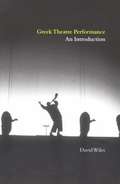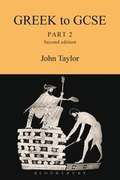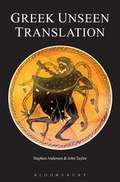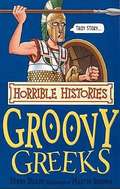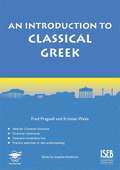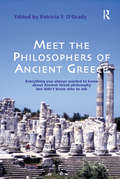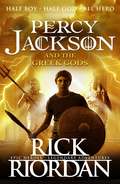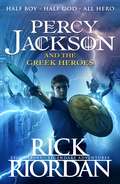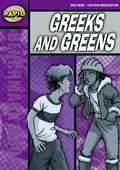Special Collections
Greeks ... groovy!
Description: Book and image resources for theme/project based learning on Greek history.
- Table View
- List View
Greek Theatre Performance
by David WilesIn this fascinating and accessible book, David Wiles introduces ancient Greek theatre to students and enthusiasts interested in knowing how the plays were performed. Theatre was a ceremony bound up with fundamental activities in ancient Athenian life and Wiles explores those elements which created the theatre of the time. Actors rather than writers are the book's main concern and Wiles examines how the actor used the resources of story-telling, dance, mask, song and visual action to create a large-scale event that would shape the life of the citizen community. The book assumes no prior knowledge of the ancient world, and is written to answer the questions of those who want to know how the plays were performed, what they meant in their original social context, what they might mean in a modern performance and what can be learned from and achieved by performances of Greek plays today.
Greek To GCSE (PDF)
by John TaylorThe two-volume course "Greek to GCSE" was written in response to a JACT survey of over 100 schools and first published in 2003. The course offer a fast-track route to GCSE for those with limited time. It is based on experience of what pupils find difficult. It concentrates on the essentials, and on the understanding of principles in both accidence and syntax. It aims to be user-friendly, but also to give pupils a firm foundation for further study. Part 1 covered the basics: the main declensions, a range of active tenses, and a vocabulary of 275 Greek words to be learned. Part 2, here issued in a new edition, introduces a wider range of grammatical forms and constructions. This revised edition has been adapted to complete the coverage of requirements for the current GCSE, expanding vocabulary to 480 words. Reading material moves from Socrates and the Sophists to the world of myth, and finally to extended passages of lightly adapted Herodotus. Practice passages and revision sentences for GCSE complete Part 2, which has a reference section covering the whole course.
Greek Tragic Theatre
by Rush RehmEmphasizing the political nature of Greek tragedy, as theatre of, by and for the polis, Rush Rehm characterizes Athens as a performance culture; one in which the theatre stood alongside other public forums as a place to confront matters of import. In treating the various social, religious and practical aspects of tragic production, he shows how these elements promoted a vision of the theatre as integral to the life of the city - a theatre focussed on the audience.
Greek Tragic Theatre (PDF)
by Rush RehmEmphasizing the political nature of Greek tragedy, as theatre of, by and for the polis, Rush Rehm characterizes Athens as a performance culture; one in which the theatre stood alongside other public forums as a place to confront matters of import. In treating the various social, religious and practical aspects of tragic production, he shows how these elements promoted a vision of the theatre as integral to the life of the city - a theatre focussed on the audience.
Greek Unseen Translation (PDF)
by Stephen Anderson and John TaylorA new collection of 120 passages from Greek authors. The first half contains twenty adapted passages building up to GCSE level, thirty lightly adapted ones for AS, and ten easy unadapted passages to introduce the translation of verse. The second half contains thirty prose and thirty verse passages of A2 standard, unadapted except by minor omissions. Vocabulary beyond the core assumed at each level is glossed.
Greek woman (large print)
by RnibThis is an image of a woman dressed in an ancient Greek-style peplos: a simple robe fashioned from a single rectangular piece of fabric. There is a locator dot shown, which will be at the top left of the page when the image is the correct way up. The woman is standing facing to the front so that all her facial features can be found. Her head is in the top centre of the page. Her hair falls to either side of her face; around it, she wears a yellow band. Down from her face you will find her neck, and to each side her shoulders with the peplos held over them by diamond-shaped pins. The woman's arms are bare. To the left, one stretches out down and left then bends right at the elbow to go down to her hand resting on her hip. To the right, her other arm hangs by her side. The robe that the woman wears is coloured green with a darker green stripe at the bottom. It is held in at the waist by a belt and hangs in many folds to her bare feet at the bottom of the page. Well-off Greek people liked to wear brightly coloured clothes, often with intricate patterns.
Greek woman (UEB contracted)
by RnibThis is an image of a woman dressed in an ancient Greek-style peplos: a simple robe fashioned from a single rectangular piece of fabric. There is a locator dot shown, which will be at the top left of the page when the image is the correct way up. The woman is standing facing to the front so that all her facial features can be found. Her head is in the top centre of the page. Her hair falls to either side of her face; around it, she wears a yellow band. Down from her face you will find her neck, and to each side her shoulders with the peplos held over them by diamond-shaped pins. The woman's arms are bare. To the left, one stretches out down and left then bends right at the elbow to go down to her hand resting on her hip. To the right, her other arm hangs by her side. The robe that the woman wears is coloured green with a darker green stripe at the bottom. It is held in at the waist by a belt and hangs in many folds to her bare feet at the bottom of the page. Well-off Greek people liked to wear brightly coloured clothes, often with intricate patterns.
Greek woman (UEB uncontracted)
by RnibThis is an image of a woman dressed in an ancient Greek-style peplos: a simple robe fashioned from a single rectangular piece of fabric. There is a locator dot shown, which will be at the top left of the page when the image is the correct way up. The woman is standing facing to the front so that all her facial features can be found. Her head is in the top centre of the page. Her hair falls to either side of her face; around it, she wears a yellow band. Down from her face you will find her neck, and to each side her shoulders with the peplos held over them by diamond-shaped pins. The woman's arms are bare. To the left, one stretches out down and left then bends right at the elbow to go down to her hand resting on her hip. To the right, her other arm hangs by her side. The robe that the woman wears is coloured green with a darker green stripe at the bottom. It is held in at the waist by a belt and hangs in many folds to her bare feet at the bottom of the page. Well-off Greek people liked to wear brightly coloured clothes, often with intricate patterns.
Hoplite (large print)
by RnibThis page shows an image of an armoured Hoplite “ a citizen-soldier from an ancient Greek city-state. Also on the page are his spear, shield and sword. There is a locator dot shown, which will be at the top left of the page when the image is the correct way up. The Hoplite is standing facing you on the right of the page. His head is turned to the right so only one eye and ear can be found. At the top centre of the page, you can find the head of the soldier's spear (the spear would have been longer than shown but has been shortened to fit on the page). Down and right is the soldier's head wearing a helmet with a red horsehair crest. His cheek and jaw are covered by a protective chin guard. Further down the page you will find his chest covered by his cuirass “ a brass breastplate. His arm to the left is holding the spear while his arm on the right hangs by his side. Down from his cuirass there is a girdle of overlapping leather scales called a pteruges and down from this he wears a short red kilt. His shins are protected by brass greaves and he wears sandals tied with leather thongs on his feet at the bottom of the page. To the right of this is his short sword with its handle at the top. To the left of his legs you will find his round shield with a Greek meander pattern around its edge and the Greek letter lambda, the symbol of the Spartans, at its centre.
Hoplite (UEB contracted)
by RnibThis page shows an image of an armoured Hoplite “ a citizen-soldier from an ancient Greek city-state. Also on the page are his spear, shield and sword. There is a locator dot shown, which will be at the top left of the page when the image is the correct way up. The Hoplite is standing facing you on the right of the page. His head is turned to the right so only one eye and ear can be found. At the top centre of the page, you can find the head of the soldier's spear (the spear would have been longer than shown but has been shortened to fit on the page). Down and right is the soldier's head wearing a helmet with a red horsehair crest. His cheek and jaw are covered by a protective chin guard. Further down the page you will find his chest covered by his cuirass “ a brass breastplate. His arm to the left is holding the spear while his arm on the right hangs by his side. Down from his cuirass there is a girdle of overlapping leather scales called a pteruges and down from this he wears a short red kilt. His shins are protected by brass greaves and he wears sandals tied with leather thongs on his feet at the bottom of the page. To the right of this is his short sword with its handle at the top. To the left of his legs you will find his round shield with a Greek meander pattern around its edge and the Greek letter lambda, the symbol of the Spartans, at its centre.
Hoplite (UEB uncontracted)
by RnibThis page shows an image of an armoured Hoplite “ a citizen-soldier from an ancient Greek city-state. Also on the page are his spear, shield and sword. There is a locator dot shown, which will be at the top left of the page when the image is the correct way up. The Hoplite is standing facing you on the right of the page. His head is turned to the right so only one eye and ear can be found. At the top centre of the page, you can find the head of the soldier's spear (the spear would have been longer than shown but has been shortened to fit on the page). Down and right is the soldier's head wearing a helmet with a red horsehair crest. His cheek and jaw are covered by a protective chin guard. Further down the page you will find his chest covered by his cuirass “ a brass breastplate. His arm to the left is holding the spear while his arm on the right hangs by his side. Down from his cuirass there is a girdle of overlapping leather scales called a pteruges and down from this he wears a short red kilt. His shins are protected by brass greaves and he wears sandals tied with leather thongs on his feet at the bottom of the page. To the right of this is his short sword with its handle at the top. To the left of his legs you will find his round shield with a Greek meander pattern around its edge and the Greek letter lambda, the symbol of the Spartans, at its centre.
Horrible Histories
by Terry Deary and Martin BrownApparently the ancient Greeks were a rather groovy bunch. The boys didn't start school until they were seven, and girls didn't have to go at all. But it wasn't always so jolly. Readers can discover why girls ran about naked pretending to be bears, who had the world's first flushing toilet and why dedicated doctors tasted their patients' ear wax! History with the nasty bits left in! 2013 is HORRIBLE HISTORIES twentieth anniversary.
Horrible Histories
by Terry Deary and Martin BrownApparently the ancient Greeks were a rather groovy bunch. The boys didn't start school until they were seven, and girls didn't have to go at all. But it wasn't always so jolly. Readers can discover why girls ran about naked pretending to be bears, who had the world's first flushing toilet and why dedicated doctors tasted their patients' ear wax! History with the nasty bits left in! 2013 is HORRIBLE HISTORIES twentieth anniversary.
An Introduction to Classical Greek (Level 1/2) (PDF)
by Kristian Waite and Fred PragnellThis textbook is ideal for any pupil working towards Level 1 or Level 2 of the Common Entrance Classical Greek exam at 13+. It introduces pupils to Greek grammar and vocabulary and features clear explanations and challenging practice questions to help pupils develop their exam technique. Several unseen passages are also included, to help pupils perfect their translation skills. Suitable for ISEB 13+ Greek exams up to and including Summer 2014. - Endorsed by ISEB - Ideal for pupils working towards Levels 1 or Level 2 of the Classical Greek Common Entrance exam at 13+ - Introduces pupils to essential Greek grammar and vocabulary - Features clear explanations followed by extensive practice questions so pupils can check what they have learnt - Unseen passages to help pupils perfect their translation skills are also included An Answer Book is also available to accompany this book. 9781905735860
Meet the Philosophers of Ancient Greece
by Patricia F. O’gradyAncient Greece was the cradle of philosophy in the Western tradition. Meet the Philosophers of Ancient Greece brings the thoughts and lives of the pioneers of Western philosophy down from their sometimes remote heights and introduces them to a modern audience. Comprising seventy essays, written by internationally distinguished scholars in a lively and accessible style, this book presents the values, ideas, wisdom and arguments of the most significant thinkers from the world of ancient Greece. Commencing with Thales of Miletus and continuing to the end of the Ancient Period of philosophy by way of Heraclitus, Parmenides, Protagoras, Socrates, Plato, Aristotle, Archimedes, Epictetus this book explores the major contributions of each philosopher as well as looking at archaeological and historical sites where they lived, worked and thought. This book is an outstanding introduction to the world of the philosophers of Ancient Greece.
Meet the Philosophers of Ancient Greece
by Patricia F. O'GradyAncient Greece was the cradle of philosophy in the Western tradition. Meet the Philosophers of Ancient Greece brings the thoughts and lives of the pioneers of Western philosophy down from their sometimes remote heights and introduces them to a modern audience. Comprising seventy essays, written by internationally distinguished scholars in a lively and accessible style, this book presents the values, ideas, wisdom and arguments of the most significant thinkers from the world of ancient Greece. Commencing with Thales of Miletus and continuing to the end of the Ancient Period of philosophy by way of Heraclitus, Parmenides, Protagoras, Socrates, Plato, Aristotle, Archimedes, Epictetus this book explores the major contributions of each philosopher as well as looking at archaeological and historical sites where they lived, worked and thought. This book is an outstanding introduction to the world of the philosophers of Ancient Greece.
Parthenon, Greece (Large Print)
by Rnib BookshareThis is an image of the end view of the Parthenon at the Acropolis. There is a locator dot shown, which will be at the top left of the page when the image is the right way up. It is an ancient Greek temple built between 447- 432 B.C. It now lies in ruin, so the stonework is rugged and irregular where it has worn away or is missing. A dashed line image border surrounds it. There are low steps with large chunks of stone missing along the base of the page, which run the width of the page. Up from these are eight Doric columns, which all have rough jagged sides. The columns rise up the page to support a series of ornamental blocks triglyphs and metopes. Above these is the pediment where a sculpted frieze would once have been.
Parthenon, Greece (UEB Contracted)
byThis is an image of the end view of the Parthenon at the Acropolis. There is a locator dot shown, which will be at the top left of the page when the image is the right way up. It is an ancient Greek temple built between 447- 432 B.C. It now lies in ruin, so the stonework is rugged and irregular where it has worn away or is missing. A dashed line image border surrounds it. There are low steps with large chunks of stone missing along the base of the page, which run the width of the page. Up from these are eight Doric columns, which all have rough jagged sides. The columns rise up the page to support a series of ornamental blocks triglyphs and metopes. Above these is the pediment where a sculpted frieze would once have been.
Parthenon, Greece (UEB uncontracted)
byThis is an image of the end view of the Parthenon at the Acropolis. There is a locator dot shown, which will be at the top left of the page when the image is the right way up. It is an ancient Greek temple built between 447- 432 B.C. It now lies in ruin, so the stonework is rugged and irregular where it has worn away or is missing. A dashed line image border surrounds it. There are low steps with large chunks of stone missing along the base of the page, which run the width of the page. Up from these are eight Doric columns, which all have rough jagged sides. The columns rise up the page to support a series of ornamental blocks triglyphs and metopes. Above these is the pediment where a sculpted frieze would once have been.
Percy Jackson and the Greek Gods
by Rick Riordan"If you like horror shows, bloodbaths, lying, stealing, backstabbing and cannibalism, then read on..." Who could tell the true stories of the gods and goddesses of Olympus better than modern-day demigod Percy Jackson? In this action-packed tour of Greek mythology, Percy gives his hilarious personal views on the feuds, fights and love affairs of the Olympians. Want to know how Zeus came to be top god? How many times Kronos ate one of his own kids? How Athena literally burst out of another god's head? It's all here in black and white...Featuring an exclusive bonus chapter from The Blood of Olympus, the fifth and final book in the Heroes of Olympus series! Rick Riordan has now sold an incredible 55 million copies of his books worldwide 'Explosive' - Big Issue 'Action-packed' - Telegraph
Percy Jackson and the Greek Heroes
by Rick Riordan and Ben HughesIF YOU LIKE POISONINGS, BETRAYALS, MUTILATIONS, MURDERS AND FLESH-EATING FARMYARD ANIMALS, KEEP READING . . .In this gripping follow-up to Percy Jackson and the Greek Gods, demigod Percy Jackson tells the stories of twelve of the original Greek heroes in all their gory, bloodthirsty glory. Want to know who cut off Medusa's head? Which hero was raised by a she-bear? Who tamed Pegasus, the winged horse? Percy has all the answers . . .
Plan of a Greek Theatre based on the theatre at Epidauros (Large Print)
byThis page shows a simplified plan (seen from above) of the outdoor theatre at Epidauros in Greece. There is a locator dot shown, which will be at the top left of the page when the image is the right way up. The plan has a dashed line image border. There is a key at the bottom left of the page. The theatre is built into the side of a hill, which forms a natural amphitheatre, with the semicircular seating area above and around the area where the drama takes place.To the right of this are the skene and proskenion with the two paradoi (the entrances for the audience) and up the page the circular area of the orchestra with the thymele (altar) at its centre. Surrounding this is the theatron, the area of tiered seating, with steps radiating out from the centre.
Plan of a Greek Theatre based on the theatre at Epidauros (UEB Contracted)
byThis page shows a simplified plan (seen from above) of the outdoor theatre at Epidauros in Greece. There is a locator dot shown, which will be at the top left of the page when the image is the right way up. The plan has a dashed line image border. There is a key at the bottom left of the page. The theatre is built into the side of a hill, which forms a natural amphitheatre, with the semicircular seating area above and around the area where the drama takes place.To the right of this are the skene and proskenion with the two paradoi (the entrances for the audience) and up the page the circular area of the orchestra with the thymele (altar) at its centre. Surrounding this is the theatron, the area of tiered seating, with steps radiating out from the centre.
Plan of a Greek Theatre based on the theatre at Epidauros (UEB Uncontracted)
byThis page shows a simplified plan (seen from above) of the outdoor theatre at Epidauros in Greece. There is a locator dot shown, which will be at the top left of the page when the image is the right way up. The plan has a dashed line image border. There is a key at the bottom left of the page. The theatre is built into the side of a hill, which forms a natural amphitheatre, with the semicircular seating area above and around the area where the drama takes place.To the right of this are the skene and proskenion with the two paradoi (the entrances for the audience) and up the page the circular area of the orchestra with the thymele (altar) at its centre. Surrounding this is the theatron, the area of tiered seating, with steps radiating out from the centre.
Rapid, Series 2, Stage 5, Assessment Book
by Reid and Dee Middleton and HaydnPART-WORK: Missing image on page 21. Scott and the Chariot Race When Scott looks in his old mirror and goes back to ancient Greece, he finds himself taking part in a chariot race. Will he win against fierce Atlas? Smoke Alert! Alex and Sarah want to make the world a greener place. One day they discover a man burning plastic bags. But is smoke pollution his only crime? Part of the Rapid Reading series, created to help children catch up. Rapid Reading is the UK's most comprehensive reading intervention programme. The books and unique speech-recognition software are guaranteed to motivate children with SEN and struggling readers at Key Stage 2 (1st/2nd Level)
